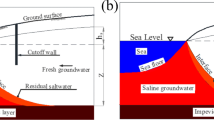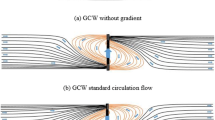Abstract
Freshwater recharge wells and underground flow barriers are among several methods proposed for controlling saltwater intrusion (SWI) into coastal aquifers. In this study, experimental and numerical studies were performed to determine the effect of using a flow barrier wall, a recharge well and a combination of these, to control SWI in unconfined coastal aquifer systems. The SEAWAT model was used to predict the SWI wedge and the behaviour of the retreating residual saltwater after installing the remediation measures. The results show that increasing the barrier wall embedment ratio (db/d) from 0.44 to 0.67 led to an increase in the repulsion ratio (R) from 20.8 to 46.87%. Moreover, increasing the freshwater injection rate ratio (Qi/Q) from 0.22 to 0.56 increased the repulsion ratio (R) from 10.93 to 22.39%. Barrier wall embedment with ratios (db/d) of 0.44, 0.51 and 0.57, combined with a freshwater injection ratio (Qi/Q) with a value of 0.56, achieved (R) of 41.14, 45.41 and 50.0%, compared with 20.8, 27.1 and 34.40% for the barrier wall only and 22.39% for freshwater injection only. Freshwater injection ratios (Qi/Q) of 0.22, 0.33, 0.44 and 0.56 combined with a barrier wall embedment ratio (db/d) of 0.508 achieved repulsion ratios (R) of 33.9, 36.5, 39.0 and 45.42%, compared with 10.9, 15.6, 18.8 and 22.4% respectively for freshwater injection only and 27.1% for the barrier wall only. A combination of flow barrier and freshwater injection forced the saltwater to retreat and achieved values of R greater than either the barrier wall or freshwater injection separately.









Similar content being viewed by others
References
Abdoulhalik A, Ahmed AA (2017) The effectiveness of cutoff walls to control saltwater intrusion in multi-layered coastal aquifers: experimental and numerical study. J Environ Manag 199:62e73
Abdoulhalik A, Ashraf A, Hamill G (2017) A new physical barrier system for seawater intrusion control. J Hydrol 549:416e427
Anwar H (1983) The effect of a subsurface barrier on the conservation of freshwater in coastal aquifers. Water Res 17:1257e1265
Attanayake P, Sholley M (2007) Evaluation of the hydraulic gradient at an island for low-level nuclear waste disposal. IAHS Publ 312:237–243
Bear J (1979) Hydraulics of groundwater. McGraw- Hill Book Co., Inc., New York
Bruington AE, Seares FD (1965) Operating a seawater barrier project. J Irrig Drain Eng 91(1):117–140
Chang SW, Clement TP (2012) Experimental and numerical investigation of saltwater intrusion dynamics in flux-controlled groundwater systems. Water Resour Res 48:W09527
Goswami RR, Clement TP (2007) Laboratory-scale investigation of saltwater intrusion dynamics. Water Resour Res 43:W04418
Guo W, Langevin CD (2002) User’s guide to SEAWAT: a computer program for simulation of three-dimensional variable-density ground-water flow. U.S. Geol. Surv., Reston
Hasan Basri M (2001) Two new methods for optimal design of subsurface barrier to control seawater intrusion. PhD Thesis. The Univ. of Manitoba
Hunt B (1985) Some analytical solutions for seawater intrusion control with recharge wells. J Hydrol 80(1–2):9–18
IPCC (2013) Summary for policymakers. In: Climate change 2013: the physical science basis. Contribution of working group I to the fifth assessment report of the intergovernmental panel on climate change. Ipcc
Luo P, Zhou M, Deng H, Lyu J, Cao W, Takara K, Nover D, Schladow SG (2018a) Impact of forest maintenance on water shortages: hydrologic modeling and effects of climate change. Sci Total Environ 615:1355–1363
Luo P, APIP, He B, Duan W, Takara K, Nover D (2018b) Impact assessment of rainfall scenarios and land-use change on hydrologic response using synthetic area IDF curves. Journal of Flood Risk Management 11:S84–S97. https://doi.org/10.1111/jfr3.12164
Luyun RA (2010) Effects of subsurface physical barrier and artificial recharge on seawater intrusion in coastal aquifers. PhD thesis. Kagoshima University, Japan
Luyun R Jr, Momii K, Nakagawa K (2009) Laboratory-scale saltwater behavior due to subsurface cutoff wall. J Hydrol 377:227e236
Luyun R Jr, Momii K, Nakagawa K (2011) Effects of recharge wells and flow barriers on seawater intrusion. Ground Water 49(2):239–249
Strack ODL (1976) A single-potential solution for regional interface problems in coastal aquifers. Water Resour Res 12(6):1165–1174
USEPA (2017) Report to congress: class V UIC study fact sheet - aquifer recharge Wells and aquifer storage and recovery Wells, EPA/ 816-R-99-014t. Office of Groundwater and Drinking Water, Washington, DC
Acknowledgments
The first author would like to thank Prof Jiro Takemura in helping to fabricate the sand box model in Tokyo Institute of Technology, Japan.
Author information
Authors and Affiliations
Corresponding author
Ethics declarations
Conflict of Interest
None.
Additional information
Publisher’s Note
Springer Nature remains neutral with regard to jurisdictional claims in published maps and institutional affiliations.
Electronic supplementary material
ESM 1
(DOCX 15503 kb)
Rights and permissions
About this article
Cite this article
Armanuos, A.M., Ibrahim, M.G., Mahmod, W.E. et al. Analysing the Combined Effect of Barrier Wall and Freshwater Injection Countermeasures on Controlling Saltwater Intrusion in Unconfined Coastal Aquifer Systems. Water Resour Manage 33, 1265–1280 (2019). https://doi.org/10.1007/s11269-019-2184-9
Received:
Accepted:
Published:
Issue Date:
DOI: https://doi.org/10.1007/s11269-019-2184-9




